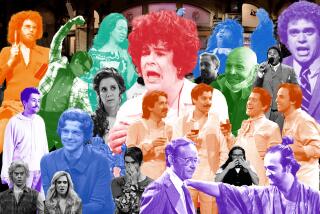Say You Threw a Party and Everybody Came
The problem with spending too much time in the shallow end of the gene pool is that the offspring embody the best of the best and the worst of the worst. In other realms, that results in things such as purebred show dogs that can barely walk. In the world of video games, it results in titles such as “Super Smash Bros.”
This Nintendo 64 cartridge has a simple and familiar premise: All the most popular characters from Nintendo’s games over the years get together and attack each other in familiar lands from Hyrule Castle to Saffron City. Imagine the pink puffball Kirby holding its own against the intergalactic bounty hunter Samus.
It could happen.
But first gamers have to suspend disbelief enough to think that Samus and Kirby might ever meet in Dream Land. Don’t know who Samus and Kirby are? Here’s a reference point: It would be like Barney, the annoying purple dinosaur, cast alongside Boba Fett of “Star Wars” in a light romantic comedy.
It’s a stretch.
For those who manage it, though, “Super Smash Bros.” offers entertaining moments with a fighting style that is more frantic yet innocent than most of the other brawlers on the market. Nintendo 64 hardly needed another fighting game, but “Super Smash Bros.” at least broadens the genre slightly.
Characters such as Donkey Kong, Mario the plumber, Pikachu the Pokemon and Yoshi the dinosaur duke it out on floating platforms. The object is to pummel an opponent to the point where he’s so tired that it’s possible to knock him off the platform.
The combatants zip across the screen, and the array of moves and power-ups is impressive. But all the while it’s impossible not to feel a little like a chump for buying into Nintendo’s tightly wound marketing machine.
Designers clearly capitalized on Nintendo’s strong stable of characters. That’s fine, but it’s getting old. First there was “Super Mario Kart.” Then there was “Diddy Kong Racing.” Then there was “Super Mario Party.”
There comes a point at which the question becomes whether Nintendo markets games or characters. Would, for instance, “Super Smash Bros.” work if it featured all new characters? There’s a strong possibility that it would. So why not give it a chance?
Hello Kitty’s Cube Frenzy
It’s no secret that parents buy video game machines primarily for children with a Y chromosome, giving rise to a chicken-and-egg type of question: Are video games written for boys because that’s who plays? Or do boys play because that’s who the games are written for?
“Hello Kitty’s Cube Frenzy” might provide an answer. This puzzler for Sony PlayStation stars Hello Kitty, the simplistic white cartoon cat that most little girls think is adorable and most little boys just don’t understand.
The goal is to help Hello Kitty collect prizes on game boards studded with sparkling blocks. She moves from side to side across the screen but can climb only one block at a time. To help her out, bundles of blocks constantly fall from the top of the screen. As in “Tetris,” players spin the blocks to create structures that enable Hello Kitty to climb up to claim her loot.
It sounds simple, but the game gets difficult quickly and challenges girls to figure out the relationships between blocks before time runs out. The reward: Hello Kitty changes outfits from level to level. It’s hardly the sort of video game gratification boys seek, but I can see the appeal to little girls.
“Hello Kitty’s Cube Frenzy” assumes a certain level of intelligence and skill and never appears to treat young players condescendingly. Unlike many other games designed for girls--most notably, the absolutely awful “Spice World”--”Hello Kitty” treats players with respect. If there were more games like this, maybe more girls would play them.
Yoot Tower
“Yoot Tower” puts would-be developers in control of skyscrapers that look and act like miniature cities. As one of the few games released first for Mac and then for the PC, “Yoot Tower” has built up a considerable following among Mac gamers.
Now that the game is available for the PC, the remaining 90% of us can see what all the fuss has been about.
It’s easy to see. “Yoot Tower” is the sequel to “Sim Tower,” and players build and manage skyscrapers in exotic locales.
But this is far more exciting than setting lease rates and busting up janitorial unions. Each skyscraper has a wild mix of shops, restaurants, apartments and even schools and medical offices.
Players decide on the mix of amenities and monitor progress to ensure that the elevators work, that hotel beds are made, that the condominiums are sold at the right price. It’s a city simulation for people who don’t like worrying about streets, sewers or power plants.
The interface is easy to use and the instruction manual is more of a reference guide than a step-by-step lesson. That’s good, because the joy of “Yoot Tower” is the ability to build eclectic utopias that tickle the clouds.
Times staff writer Aaron Curtiss reviews video games every Monday in The Cutting Edge. To comment on a column or to suggest games for review, send e-mail to aaron.curtiss@latimes.com.
(BEGIN TEXT OF INFOBOX / INFOGRAPHIC)
ESSENTIALS
Title: Super Smash Bros.
Platform: Nintendo 64
Publisher: Nintendo
ESRB rating: Everyone
Price: $59.95
Bottom line: Mortal Kombat meets Mario
Title: Hello Kitty’s Cube Frenzy
Platform: Sony PlayStation
Publisher: NewKidCo
ESRB rating: Everyone
Price: $39.95
Bottom line: Too cute by far, but still fun
Title: Yoot Tower
Platform: PC/Macintosh
Publisher: Sega PC
ESRB rating: Everyone
Price: $39.95
Bottom line: Sim City for Fred and Ethel
Next Week: TK
More to Read
The biggest entertainment stories
Get our big stories about Hollywood, film, television, music, arts, culture and more right in your inbox as soon as they publish.
You may occasionally receive promotional content from the Los Angeles Times.










